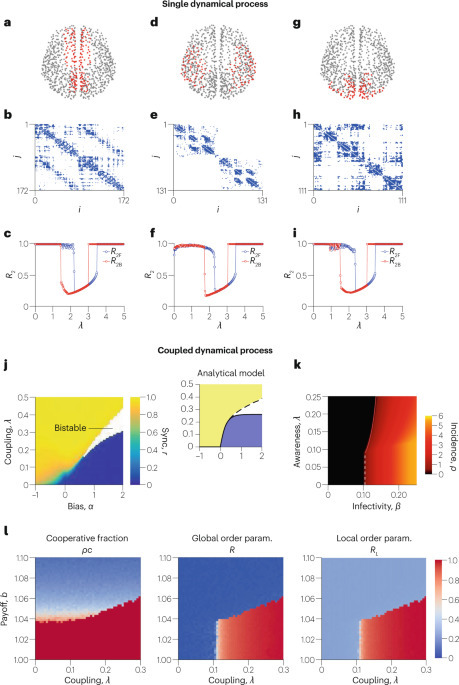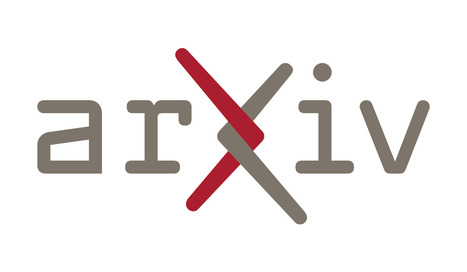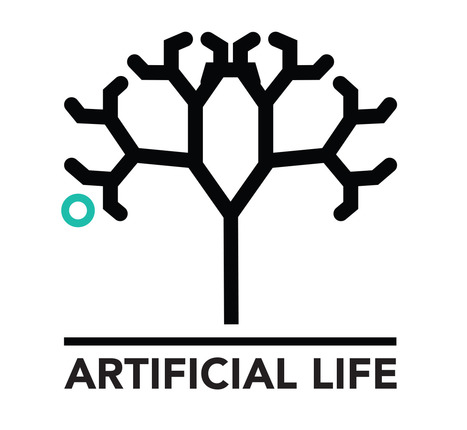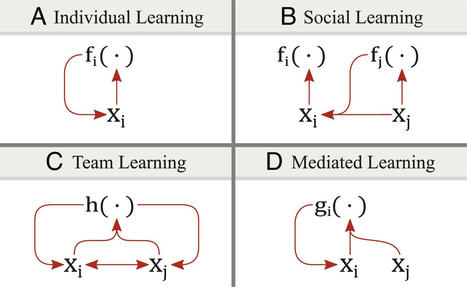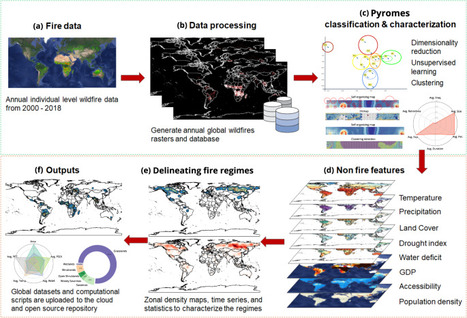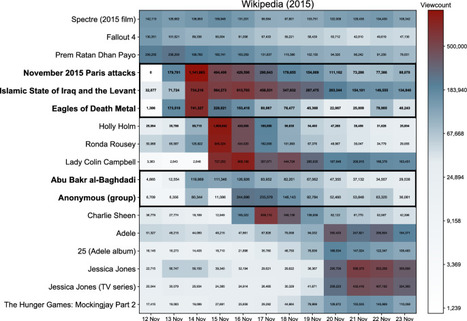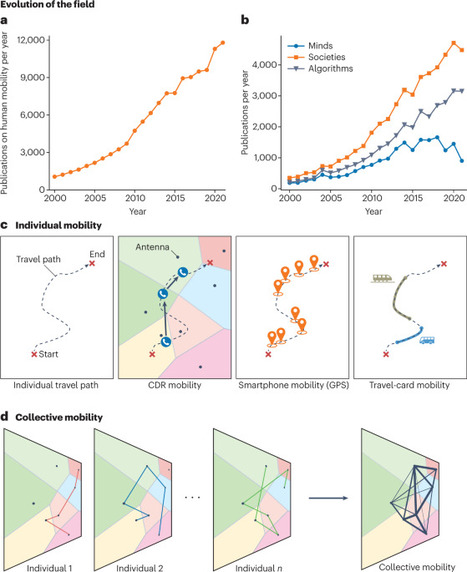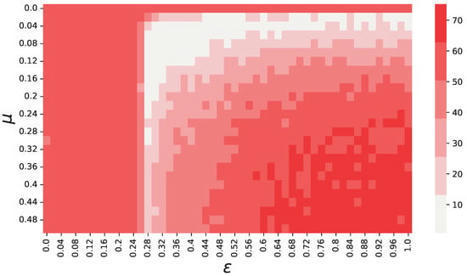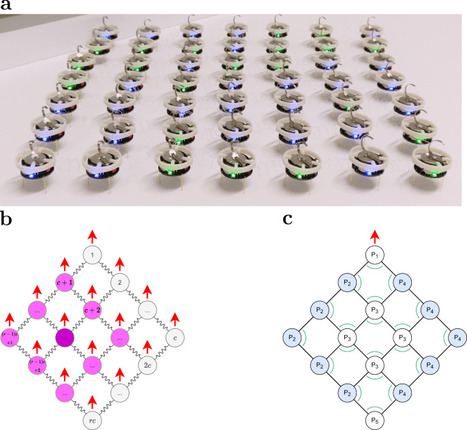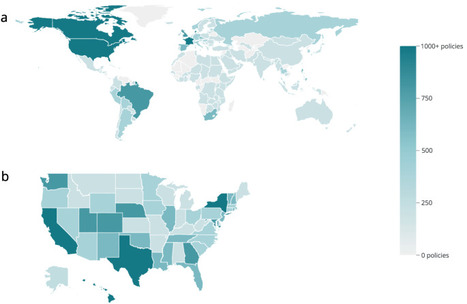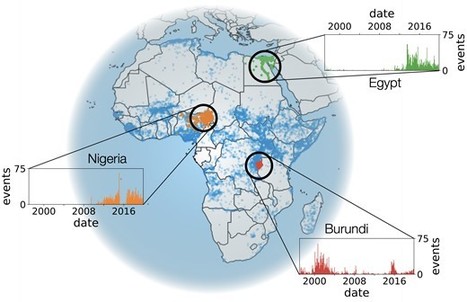 Your new post is loading...
 Your new post is loading...

|
Scooped by
Complexity Digest
September 3, 2023 3:48 PM
|
Manlio De Domenico
Nature Physics (2023) The constituents of many complex systems are characterized by non-trivial connectivity patterns and dynamical processes that are well captured by network models. However, most systems are coupled with each other through interdependencies, characterized by relationships among heterogeneous units, or multiplexity, characterized by the coexistence of different kinds of relationships among homogeneous units. Multilayer networks provide the framework to capture the complexity typical of systems of systems, enabling the analysis of biophysical, social and human-made networks from an integrated perspective. Here I review the most important theoretical developments in the past decade, showing how the layered structure of multilayer networks is responsible for phenomena that cannot be observed from the analysis of subsystems in isolation or from their aggregation, including enhanced diffusion, emergent mesoscale organization and phase transitions. I discuss applications spanning multiple spatial scales, from the cell to the human brain and to ecological and social systems, and offer perspectives and challenges on future research directions. Read the full article at: www.nature.com

|
Scooped by
Complexity Digest
September 1, 2023 2:19 PM
|
Marina Dubova, Mirta Galesic, Robert L. Goldstone Cognitive Science 46(12) Cognitive science has been traditionally organized around the individual as the basic unit of cognition. Despite developments in areas such as communication, human–machine interaction, group behavior, and community organization, the individual-centric approach heavily dominates both cognitive research and its application. A promising direction for cognitive science is the study of augmented intelligence, or the way social and technological systems interact with and extend individual cognition. The cognitive science of augmented intelligence holds promise in helping society tackle major real-world challenges that can only be discovered and solved by teams made of individuals and machines with complementary skills who can productively collaborate with each other. Read the full article at: onlinelibrary.wiley.com

|
Scooped by
Complexity Digest
August 31, 2023 10:28 AM
|
David Fajardo-Ortiz, Bart Thijs, Wolfgang Glanzel, Karin R. Sipido The historical research-funding model, based on the curiosity and academic interests of researchers, is giving way to new strategic funding models that seek to meet societal needs. We investigated the impact of this trend on health research funded by the two leading funding bodies worldwide, i.e. the National Institutes of Health (NIH) in the United States, and the framework programs of the European Union (EU). To this end, we performed a quantitative analysis of the content of projects supported through programmatic funding by the EU and NIH, in the period 2008-2014 and 2015-2020. We used machine learning for classification of projects as basic biomedical research, or as more implementation directed clinical therapeutic research, diagnostics research, population research, or policy and management research. In addition, we analyzed funding for major disease areas (cancer, cardio-metabolic and infectious disease). We found that EU collaborative health research projects clearly shifted towards more implementation research. In the US, the recently implemented UM1 program has a similar profile with strong clinical therapeutic research, while other NIH programs remain heavily oriented to basic biomedical research. Funding for cancer research is present across all NIH and EU programs, and in biomedical as well as more implementation directed projects, while infectious diseases is an emerging theme. We conclude that demand for solutions for medical needs leads to expanded funding for implementation- and impact-oriented research. Basic biomedical research remains present in programs driven by scientific initiative and strategies based on excellence, but may be at risk of declining funding opportunities. Read the full article at: arxiv.org

|
Scooped by
Complexity Digest
August 27, 2023 9:51 AM
|
Luisa Damiano, Pasquale Stano Artificial Life (2023) 29 (3): 289–292. The proposal for this special issue was inspired by the main themes around which we organize a series of satellite workshops at Artificial Life conferences (including some of the latest European Conferences on Artificial Life), the title of which is “SB-AI: What can Synthetic Biology (SB) offer to Artificial Intelligence (AI)?” The workshop themes are part of a larger scenario in which we are interested and which we intend to develop. This scenario includes the entire taxonomy of new research frontiers generated within AI, based on the construction and experimental exploration of software, hardware, wetware, and mixed synthetic models to deepen the scientific understanding of biological cognition. Read the full article at: direct.mit.edu

|
Scooped by
Complexity Digest
August 26, 2023 11:54 AM
|
How hard is it to prove that problems are hard to solve? Meta-complexity theorists have been asking questions like this for decades. A string of recent results has started to deliver answers. Read the full article at: www.quantamagazine.org

|
Scooped by
Complexity Digest
August 25, 2023 2:50 PM
|
John Meluso and Laurent Hébert-Dufresne PNAS 120 (34) e2303568120 Like chefs at a fast-moving restaurant or engineers in a multidisciplinary project, team members often complete separate, interrelated subsets of larger tasks with limited insight into the work of others. These contexts make it difficult for individuals to assess the value of their own contribution to the collective work. Our work shows that despite this obstacle, individuals can still learn from their neighbors when neighbors’ actions influence collective outcomes. Though the effects are modest, we found that teams with more interactions between members perform better when refining their work while teams with fewer interactions perform better when innovating. We also found that across 34 tasks with diverse qualities, teams that decentralize coordination responsibilities outperform those that do not. Read the full article at: www.pnas.org

|
Scooped by
Complexity Digest
August 25, 2023 11:53 AM
|
Why did mammals, grasses and some other groups of organisms explode in diversity only after millions of years? The evolutionary biologist Andreas Wagner plumbs the secrets of those “sleeping beauties.” Read the full article at: www.quantamagazine.org

|
Scooped by
Complexity Digest
August 9, 2023 8:24 AM
|
Calvo Martín M, Rodriguez Palacio E, Deneubourg J-L, Nicolis SC PLoS ONE 18(7): e0287845 The stability of collective decisions-making in social systems is crucial as it can lead to counterintuitive phenomena such as collective memories, where an initial choice is challenged by environmental changes. Many social species face the challenge to perform collective decisions under variable conditions. In this study, we focused on situations where isolated individuals and groups of the American cockroach (Periplaneta americana) had to choose between two shelters with different luminosities that were inverted during the experiment. The darker shelter was initially preferred, but only groups that reached a consensus within that shelter maintain their choice after the light inversion, while isolated individuals and small groups lacked site fidelity. Our mathematical model, incorporating deterministic and probabilistic elements, sheds light on the significance interactions and their stochasticity in the emergence and retention of a collective memory. Read the full article at: journals.plos.org

|
Scooped by
Complexity Digest
August 6, 2023 10:57 AM
|
Conor Heins, Beren Millidge, Lancelot da Costa, Richard Mann, Karl Friston, Iain Couzin
Collective motion is ubiquitous in nature; groups of animals, such as fish, birds, and ungulates appear to move as a whole, exhibiting a rich behavioral repertoire that ranges from directed movement to milling to disordered swarming. Typically, such macroscopic patterns arise from decentralized, local interactions among constituent components (e.g., individual fish in a school). Preeminent models of this process describe individuals as self-propelled particles, subject to self-generated motion and 'social forces' such as short-range repulsion and long-range attraction or alignment. However, organisms are not particles; they are probabilistic decision-makers. Here, we introduce an approach to modelling collective behavior based on active inference. This cognitive framework casts behavior as the consequence of a single imperative: to minimize surprise. We demonstrate that many empirically-observed collective phenomena, including cohesion, milling and directed motion, emerge naturally when considering behavior as driven by active Bayesian inference -- without explicitly building behavioral rules or goals into individual agents. Furthermore, we show that active inference can recover and generalize the classical notion of social forces as agents attempt to suppress prediction errors that conflict with their expectations. By exploring the parameter space of the belief-based model, we reveal non-trivial relationships between the individual beliefs and group properties like polarization and the tendency to visit different collective states. We also explore how individual beliefs about uncertainty determine collective decision-making accuracy. Finally, we show how agents can update their generative model over time, resulting in groups that are collectively more sensitive to external fluctuations and encode information more robustly. Read the full article at: arxiv.org

|
Scooped by
Complexity Digest
August 5, 2023 12:27 PM
|
JOSEPH L.-H. TSUI, et al. SCIENCE 20 Jul 2023 Vol 381, Issue 6655 pp. 336-343 Severe acute respiratory syndrome coronavirus 2 (SARS-CoV-2) variants of concern (VOCs) now arise in the context of heterogeneous human connectivity and population immunity. Through a large-scale phylodynamic analysis of 115,622 Omicron BA.1 genomes, we identified >6,000 introductions of the antigenically distinct VOC into England and analyzed their local transmission and dispersal history. We find that six of the eight largest English Omicron lineages were already transmitting when Omicron was first reported in southern Africa (22 November 2021). Multiple datasets show that importation of Omicron continued despite subsequent restrictions on travel from southern Africa as a result of export from well-connected secondary locations. Initiation and dispersal of Omicron transmission lineages in England was a two-stage process that can be explained by models of the country’s human geography and hierarchical travel network. Our results enable a comparison of the processes that drive the invasion of Omicron and other VOCs across multiple spatial scales. Read the full article at: www.science.org

|
Scooped by
Complexity Digest
August 4, 2023 11:02 PM
|
The proof establishes new conditions that cause connected oscillators to sway in sync. Read the full article at: www.quantamagazine.org

|
Scooped by
Complexity Digest
August 4, 2023 3:03 PM
|
Cristobal Pais, Jose Ramon Gonzalez-Olabarria, Pelagie Elimbi Moudio, Jordi Garcia-Gonzalo, Marta C. González & Zuo-Jun Max Shen
Communications Earth & Environment volume 4, Article number: 267 (2023) Different interpretations of the fire regime concept have limited the capacity to allocate specific fire regimes worldwide. To solve this limitation, in this study, we present a framework to frame contemporary fire regimes spatially on a global scale. We process historical wildfire records between 2000 and 2018 across the six continents. We uncover 15 global pyromes with clear differences in fire-related metrics, such as frequency and size. The pyromes were further divided into 62 regimes based on spatial aggregation patterns. This spatial framing of contemporary fire regimes allows for an interpretation of how a combination of driving factors such as vegetation, climate, and demographic features can result in a specific fire regime. To the best of our knowledge, this open source platform at unprecedented scale expands on existing classification efforts and bridges the gaps between global and regional fire studies. A framework to classify fire regimes spatially on a global scale based on historical records between 2000 and 2018 reveals 15 global pyromes with differences in fire-related metrics and indicates how factors such as vegetation, climate, and demographic features can result in a specific fire regime. Read the full article at: www.nature.com

|
Scooped by
Complexity Digest
August 4, 2023 10:53 AM
|
Milan Jović, Lovro Šubelj, Tea Golob, Matej Makarovič, Taha Yasseri, Danijela Boberić Krstićev, Srdjan Škrbić & Zoran Levnajić
Scientific Reports volume 13, Article number: 12451 (2023) Terrorist attacks not only harm citizens but also shift their attention, which has long-lasting impacts on public opinion and government policies. Yet measuring the changes in public attention beyond media coverage has been methodologically challenging. Here we approach this problem by starting from Wikipedia’s répertoire of 5.8 million articles and a sample of 15 recent terrorist attacks. We deploy a complex exclusion procedure to identify topics and themes that consistently received a significant increase in attention due to these incidents. Examining their contents reveals a clear picture: terrorist attacks foster establishing a sharp boundary between “Us” (the target society) and “Them” (the terrorist as the enemy). In the midst of this, one seeks to construct identities of both sides. This triggers curiosity to learn more about “Them” and soul-search for a clearer understanding of “Us”. This systematic analysis of public reactions to disruptive events could help mitigate their societal consequences. Read the full article at: www.nature.com
|

|
Scooped by
Complexity Digest
September 3, 2023 10:43 AM
|
Luca Pappalardo, Ed Manley, Vedran Sekara & Laura Alessandretti
Nature Computational Science volume 3, pages 588–600 (2023) We provide a brief review of human mobility science and present three key areas where we expect to see substantial advancements. We start from the mind and discuss the need to better understand how spatial cognition shapes mobility patterns. We then move to societies and argue the importance of better understanding new forms of transportation. We conclude by discussing how algorithms shape mobility behavior and provide useful tools for modelers. Finally, we discuss how progress on these research directions may help us address some of the challenges our society faces today. Read the full article at: www.nature.com

|
Scooped by
Complexity Digest
August 31, 2023 10:57 AM
|
Alessandro Scirè & Valerio Annovazzi-Lodi Theory in Biosciences volume 142, pages 291–299 (2023) This work concerns a many-body deterministic model that displays life-like properties such as emergence, complexity, self-organization, self-regulation, excitability and spontaneous compartmentalization. The model portraits the dynamics of an ensemble of locally coupled polar phase oscillators, moving in a two-dimensional space, that under certain conditions exhibit emergent superstructures. Those superstructures are self-organized dynamic networks, resulting from a synchronization process of many units, over length scales much greater than the interaction range. Such networks compartmentalize the two-dimensional space with no a priori constraints, due to the formation of porous transport walls, and represent a highly complex and novel non-linear behavior. The analysis is numerically carried out as a function of a control parameter showing distinct regimes: static pattern formation, dynamic excitable networks formation, intermittency and chaos. A statistical analysis is drawn to determine the control parameter ranges for the various behaviors to appear. The model and the results shown in this work are expected to contribute to the field of artificial life. Read the full article at: link.springer.com

|
Scooped by
Complexity Digest
August 30, 2023 10:55 AM
|
Valerio Restocchi, Frank McGroarty, Enrico Gerding and Markus Brede
Entropy 2023, 25(8), 1152; DOI: 10.3390/e25081152 Prediction markets are heralded as powerful forecasting tools, but models that describe them often fail to capture the full complexity of the underlying mechanisms that drive price dynamics. To address this issue, we propose a model in which agents belong to a social network, have an opinion about the probability of a particular event to occur, and bet on the prediction market accordingly. Agents update their opinions about the event by interacting with their neighbours in the network, following the Deffuant model of opinion dynamics. Our results suggest that a simple market model that takes into account opinion formation dynamics is capable of replicating the empirical properties of historical prediction market time series, including volatility clustering and fat-tailed distribution of returns. Interestingly, the best results are obtained when there is the right level of variance in the opinions of agents. Moreover, this paper provides a new way to indirectly validate opinion dynamics models against real data by using historical data obtained from PredictIt, which is an exchange platform whose data have never been used before to validate models of opinion diffusion. Read the full article at: www.mdpi.com

|
Scooped by
Complexity Digest
August 26, 2023 2:46 PM
|
Matthew R. DeVerna, Harry Yaojun Yan, Kai-Cheng Yang, Filippo Menczer Fact checking can be an effective strategy against misinformation, but its implementation at scale is impeded by the overwhelming volume of information online. Recent artificial intelligence (AI) language models have shown impressive ability in fact-checking tasks, but how humans interact with fact-checking information provided by these models is unclear. Here we investigate the impact of fact checks generated by a popular AI model on belief in, and sharing intent of, political news in a preregistered randomized control experiment. Although the AI performs reasonably well in debunking false headlines, we find that it does not significantly affect participants' ability to discern headline accuracy or share accurate news. However, the AI fact-checker is harmful in specific cases: it decreases beliefs in true headlines that it mislabels as false and increases beliefs for false headlines that it is unsure about. On the positive side, the AI increases sharing intents for correctly labeled true headlines. When participants are given the option to view AI fact checks and choose to do so, they are significantly more likely to share both true and false news but only more likely to believe false news. Our findings highlight an important source of potential harm stemming from AI applications and underscore the critical need for policies to prevent or mitigate such unintended consequences. Read the full article at: arxiv.org

|
Scooped by
Complexity Digest
August 26, 2023 10:59 AM
|
David Sloan Wilson, Guru Madhavan, Michele J. Gelfand, Steven C. Hayes, Paul W. B. Atkins, and Rita R. Colwell PNAS 120 (16) e2218222120 Evolutionary science has led to many practical applications of genetic evolution but few practical uses of cultural evolution. This is because the entire study of evolution was gene centric for most of the 20th century, relegating the study and application of human cultural change to other disciplines. The formal study of human cultural evolution began in the 1970s and has matured to the point of deriving practical applications. We provide an overview of these developments and examples for the topic areas of complex systems science and engineering, economics and business, mental health and well-being, and global change efforts. Read the full article at: www.pnas.org

|
Scooped by
Complexity Digest
August 25, 2023 1:14 PM
|
Subhash Kak Theory in Biosciences volume 142, pages 205–210 (2023) This paper addresses the relationship between information and structure of the genetic code. The code has two puzzling anomalies: First, when viewed as 64 sub-cubes of a 4×4×4 cube, the codons for serine (S) are not contiguous, and there are amino acid codons with zero redundancy, which goes counter to the objective of error correction. To make sense of this, the paper shows that the genetic code must be viewed not only on stereochemical, co-evolution, and error-correction considerations, but also on two additional factors of significance to natural systems, that of an information-theoretic dimensionality of the code data, and the principle of maximum entropy. One implication of non-integer dimensionality associated with data dimensions is self-similarity to different scales, and it is shown that the genetic code does satisfy this property, and it is further shown that the maximum entropy principle operates through the scrambling of the elements in the sense of maximum algorithmic information complexity, generated by an appropriate exponentiation mapping. It is shown that the new considerations and the use of maximum entropy transformation create new constraints that are likely the reasons for the non-uniform codon groups and codons with no redundancy. Read the full article at: link.springer.com

|
Scooped by
Complexity Digest
August 10, 2023 12:13 AM
|
Jelena Joksimović , Matjaž Perc and Zoran Levnajić Roy. Soc. Open Science August 2023 Volume 10 Issue 8 Private businesses are often entrusted with public contracts, wherein public money is allocated to a private company. This process raises concerns about transparency, even in the most developed democracies. But are there any regularities guiding this process? Do all private companies benefit equally from the state budgets? Here, we tackle these questions focusing on the case of Slovenia, which keeps excellent records of this kind of public spending. We examine a dataset detailing every transfer of public money to the private sector from January 2003 to May 2020. During this time, Slovenia has conducted business with no less than 248 989 private companies. We find that the cumulative distribution of money received per company can be reasonably well explained by a power-law or lognormal fit. We also show evidence for the first-mover advantage, and determine that companies receive new funding in a way that is roughly linear over time. These results indicate that, despite all human factors involved, Slovenian public spending is at least to some extent regulated by emergent self-organizing principles. Read the full article at: royalsocietypublishing.org

|
Scooped by
Complexity Digest
August 8, 2023 5:51 PM
|
Pratissoli, F., Reina, A., Kaszubowski Lopes, Y. et al. Nature Communications 14, 4063 (2023). We investigate how reliable movement can emerge in aggregates of highly error-prone individuals. The individuals—robotic modules—move stochastically using vibration motors. By coupling them via elastic links, soft-bodied aggregates can be created. We present distributed algorithms that enable the aggregates to move and deform reliably. The concept and algorithms are validated through formal analysis of the elastic couplings and experiments with aggregates comprising up to 49 physical modules—among the biggest soft-bodied aggregates to date made of autonomous modules. The experiments show that aggregates with elastic couplings can shrink and stretch their bodies, move with a precision that increases with the number of modules, and outperform aggregates with no, or rigid, couplings. Our findings demonstrate that mechanical couplings can play a vital role in reaching coherent motion among individuals with exceedingly limited and error-prone abilities, and may pave the way for low-power, stretchable robots for high-resolution monitoring and manipulation. In biology, individuals are known to achieve higher navigation accuracy when moving in a group compared to single animals. The authors show that simple self-propelled robotic modules that are incapable of accurate motion as individuals can achieve accurate group navigation once coupled via deformable elastic links. Read the full article at: www.nature.com

|
Scooped by
Complexity Digest
August 6, 2023 12:28 AM
|
Rebecca Katz, Kate Toole, Hailey Robertson, Alaina Case, Justin Kerr, Siobhan Robinson-Marshall, Jordan Schermerhorn, Sarah Orsborn, Michael Van Maele, Ryan Zimmerman, Tess Stevens, COVID AMP Coding Team, Alexandra Phelan, Colin Carlson & Ellie Graeden
Scientific Data volume 10, Article number: 491 (2023)
As the COVID-19 pandemic unfolded in the spring of 2020, governments around the world began to implement policies to mitigate and manage the outbreak. Significant research efforts were deployed to track and analyse these policies in real-time to better inform the response. While much of the policy analysis focused narrowly on social distancing measures designed to slow the spread of disease, here, we present a dataset focused on capturing the breadth of policy types implemented by jurisdictions globally across the whole-of-government. COVID Analysis and Mapping of Policies (COVID AMP) includes nearly 50,000 policy measures from 150 countries, 124 intermediate areas, and 235 local areas between January 2020 and June 2022. With up to 40 structured and unstructured characteristics encoded per policy, as well as the original source and policy text, this dataset provides a uniquely broad capture of the governance strategies for pandemic response, serving as a critical data source for future work in legal epidemiology and political science. Read the full article at: www.nature.com

|
Scooped by
Complexity Digest
August 5, 2023 10:58 AM
|
For over a century, biologists have had to contend with a complicated picture of genetics, which they’ve only recently begun to understand. Read the full article at: www.quantamagazine.org

|
Scooped by
Complexity Digest
August 4, 2023 5:50 PM
|
A. Reina, T. Bose, V. Srivastava, J.A.R. Marshall Royal Society Open Science 10: 230175, 2023. It is usually assumed that information cascades are most likely to occur when an early but incorrect opinion spreads through the group. Here, we analyse models of confidence-sharing in groups and reveal the opposite result: simple but plausible models of naive-Bayesian decision-making exhibit information cascades when group decisions are synchronous; however, when group decisions are asynchronous, the early decisions reached by Bayesian decision-makers tend to be correct and dominate the group consensus dynamics. Thus early decisions actually rescue the group from making errors, rather than contribute to it. We explore the likely realism of our assumed decision-making rule with reference to the evolution of mechanisms for aggregating social information, and known psychological and neuroscientific mechanisms. Read the full article at: royalsocietypublishing.org

|
Scooped by
Complexity Digest
August 4, 2023 12:56 PM
|
Niraj Kushwaha, Edward D Lee
PNAS Nexus, Volume 2, Issue 7, July 2023, pgad228 Conflicts, like many social processes, are related events that span multiple scales in time, from the instantaneous to multi-year development, and in space, from one neighborhood to continents. Yet, there is little systematic work on connecting the multiple scales, formal treatment of causality between events, and measures of uncertainty for how events are related to one another. We develop a method for extracting causally related chains of events that addresses these limitations with armed conflict. Our method explicitly accounts for an adjustable spatial and temporal scale of interaction for clustering individual events from a detailed data set, the Armed Conflict Event & Location Data Project. With it, we discover a mesoscale ranging from a week to a few months and tens to hundreds of kilometers, where long-range correlations and nontrivial dynamics relating conflict events emerge. Importantly, clusters in the mesoscale, while extracted from conflict statistics, are identifiable with mechanism cited in field studies. We leverage our technique to identify zones of causal interaction around conflict hotspots that naturally incorporate uncertainties. Thus, we show how a systematic, data-driven, and scalable procedure extracts social objects for study, providing a scope for scrutinizing and predicting conflict and other processes. Read the full article at: academic.oup.com
|



 Your new post is loading...
Your new post is loading...

